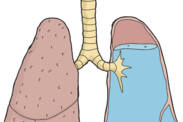Symptoms associated with the respiratory system

Dry cough
A dry irritating cough is a common symptom of a respiratory infection. In addition, it can be a symptom of a number of other diseases. Coughing also functions as a defence reflex.

Hiccups
Hiccups occur quite frequently. But what can be done if it is too frequent? Can it be a manifestation of a more serious problem?

Lung Island
Pulmonary oedema is a serious and life-threatening condition if it occurs suddenly (acutely). Its chronic form is milder. It can be caused by chest trauma, pneumonia, drowning or inhalation of a foreign body. It is more common as a consequence of heart failure in the elderly population. It can also develop in pregnancy during eclampsia. Symptoms include breathlessness and other discomforts.

Spirituality
Shortness of breath is characterized by a feeling of not getting enough air. Shortness of breath is often described by a feeling of choking or not getting enough breath. It is a symptom of various health problems and diseases.

Coughing up blood
Coughing up blood, coughing up blood with mucus when coughing, coughing up small or large amounts of blood can be a sign of a serious illness. This symptom requires a professional examination.

Coughing up mucus
Under normal circumstances, mucus has a protective function. Its increased production is caused by certain diseases. An example of this is infection with viruses or bacteria. In this case, excess mucus must be removed from the airways. And this is what coughing is for.

Damp cough
Coughing is a defence mechanism of the body. It ensures the passage of the airways. The mucus formed by it performs a defensive function. But in some diseases it is formed in an increased amount and needs to be coughed up. It occurs as a symptom in various diseases.

Hoarseness
This symptom arises in respiratory tract infections, but also as a consequence of congestion. Typically, hoarseness occurs in children when they have mucus leaking from their upper airways. It also occurs in laryngitis. A special group are diseases of the vocal cords. Cancer is also a serious cause of hoarseness.
The respiratory system is essential for every living organism and ensures the exchange of gases between the organism and the environment. With the help of the respiratory system, the human organism obtains oxygen, which is essential for its elementary functioning, and at the same time gets rid of carbon dioxide. In plants, the process is reversed and they, in turn, produce oxygen. The respiratory system is divided vertically into the upper respiratory tract and the lower respiratory tract, which together form the respiratory system.
The mechanism of respiration has four phases. The first is the ventilation of the lungs, when the transfer of air from the surroundings to the lungs and vice versa occurs. The second is external respiration, here the exchange of respiratory gases between the pulmonary alveoli and the blood occurs. This is followed by internal respiration, where the exchange of gases between blood cells and cellular tissues already occurs. Respiration itself is the last stage and here the breakdown of nutrients in the body cells already occurs. The problem can occur at any stage.
As such, breathing is regulated in the centre of the medulla oblongata, and the activity is of course also influenced by the brain. It is therefore also possible to freely and consciously regulate the frequency of breathing as well as the depth of inhalation and exhalation. However, the respiratory system also has automatic defence reflexes that are activated without the person's knowledge by the presence of irritation, foreign particles or substances, in particular sneezing, coughing and noisy exhalations.
Symptoms related to the respiratory system usually affect both the lower and upper respiratory system and are related to a variety of diseases. Of course, respiratory diseases are the most prevalent, causing problems with gas exchange, various infections and inflammation in both the lower and upper airways, but sometimes respiratory-related symptoms can also be manifested by diseases such as cardiovascular diseases.
While such a cough is a fairly common symptom that occurs with frequent respiratory diseases, for example, pressure in the chest can be caused by a variety of disease states or disruption of the tissues in this area. Some symptoms may also be related to problems of the digestive system, such as excessive coughing or shortness of breath, while others are directly related to life-threatening conditions, such as when breathing stops and death is imminent.
Gentle coughing and hoarseness
In most cases, a slight cough may not mean a more serious problem, as it helps the respiratory system to get rid of mucus, for example. The problem is more likely to occur if it is a more serious symptom that is also associated with difficult breathing, such as pneumothorax. Sometimes this can be a psychosomatic cause, but there are also cases where pharyngitis or, worse, lung cancer starts in this way. However, this must have been coughing for much longer.
Hoarseness, on the other hand, is a voice disorder and can be caused quite commonly by excessive strain on the vocal cords. However, it is important to have a professional examination to determine whether there is an obstruction directly in the vocal cords, or if there is inflammation of the vocal cords. Hoarseness is also sometimes associated with oesophageal reflux disease, which is also a digestive problem. It is most often associated with laryngitis, but it can also occur, for example, when an obstruction is unintentionally stuck in the throat, which is already a life-threatening condition.
Slowed or accelerated breathing?
Slowed breathing usually occurs as a complication of heavy breathing and is professionally called bradypnoea. It can sometimes also be accompanied by chest pain and is typically caused by cough suppressants. However, slowed breathing is also a symptom of intoxication, hypothyroidism, head and brain injuries such as brain haemorrhage or some metabolic diseases. It should certainly be given due attention.
Rapid breathing, called tachypnea, occurs, for example, in poisoning by various gases, when the body tries to hyperventilate to obtain the air needed for cellular function. It also accompanies various shock conditions and injuries, possibly strokes and traumatic injuries. It is sometimes part of the manifestations of asthma or bronchitis, or in colicky pains, when a person may feel subjective relief with faster respiration.
Problem with exhalation and chest pressure
Problem breathing typically occurs as part of the symptoms of asthma, which is a serious respiratory disease requiring specialist treatment and management. Also, in some lung diseases, such as pulmonary embolism or pulmonary emphysema, a person may have difficulty exhaling previously inhaled air due to disruption of lung tissue and function. Sometimes a feeling of pressure in the chest may be associated with this, although in this case it is a symptom associated not only with breathing difficulties.
Chest pressure is also experienced by people with cardiovascular problems, for example, in pericarditis, angina pectoris or ischaemic heart disease. Also, several serious conditions, such as myocardial infarction, are accompanied by this symptom. If there is also pain, the integrity of the chest and rib cage may be compromised, for example in the case of a fracture or impingement.
Shortness of breath and breathing problems
While some breathing problems are only of a short-term nature for a few seconds, for example with hiccups, shortness of breath manifests itself in longer-term problems of smooth breathing. When shortness of breath occurs, breathing is typically labored, sometimes even slowed. It is most often a symptom of various lung diseases, but also of infectious and inflammatory diseases, or problems with poor functioning of the heart and cardiovascular system.
Of the respiratory diseases, shortness of breath most often occurs in chronic lung disease, whooping cough, tuberculosis, chronic bronchitis or hypoxia. Difficult breathing also occurs in some cardiovascular disorders, such as atherosclerosis, heart defects, irregular heartbeat or myocardial infarction. Difficult breathing is also seen in a number of life-threatening conditions, whether after injury or in cerebral haemorrhage.
Short-term cessation of breathing is typical of sleep apnoea syndrome, which is a sleep disorder, but is characterised by a brief cessation of breathing for a few seconds followed by deep breaths. Sometimes a similar symptom occurs in epileptic seizures or when the breath is knocked out, which often happens in sports or following a traumatic event. In this case, breathing is restored by minor blows between the shoulder blades.
Dry cough vs. wet cough
Coughing is quite common, especially in respiratory diseases. Dry cough, also called irritant cough, occurs when a person does not cough up anything and typically occurs in both upper and lower respiratory tract diseases. These include influenza, bronchitis or even tuberculosis of the lungs or laryngitis. Many times it is associated with allergic-type diseases, for example asthma attacks. Sometimes this type of cough can also be observed when the mucous membrane of the respiratory system is irritated by a foreign element.
A moist cough, on the other hand, is productive and related to expectoration. It is typical of many respiratory diseases such as whooping cough, chronic obstructive pulmonary disease, influenza, bronchitis and rotavirus enteritis. This cough is also often associated with and usually follows a dry cough. It is typically present in pneumonia, but also in other febrile illnesses. There is coughing, usually of mucus, and a stuffy nose is an accompanying feature.
Coughing is not always a problem
Coughing up mucus can help the body, especially if a person is suffering from respiratory diseases of the lower respiratory tract, especially bronchitis or influenza. It is often associated with a productive or wet cough, so that the mucus in the lungs is expelled out of the body and the person can breathe better. Sometimes, however, it is also a symptom of a more serious condition, such as chronic bronchitis or whooping cough, which is fortunately rare.
When coughing up pus, the problem is usually more complex and this symptom is associated with problems in both the lower and upper respiratory system. The most common symptom is first a dry cough, which is later replaced by a wet cough with coughing up of pus and usually accompanied by a high temperature. For example, this is the case in pneumonia or chronic obstructive pulmonary syndrome. Sometimes coughing up pus also occurs in asthma.
The most serious symptom when coughing up blood is coughing up blood. It can also be a symptom of a life-threatening condition, such as pulmonary embolism. Also, in more serious inflammation of the lung tissue, blood is sometimes seen, possibly in chronic bronchitis. If a person even loses weight, it is also realistic to suspect cancer somewhere in the lungs or in another part of the airways. However, it is important to distinguish whether there is also a digestive problem if blood is coming from the oesophagus.
Swellings and effusions on the lungs
Pleural effusion on the lungs is a rather serious symptom, which usually indicates a disease not only of the respiratory system. Pleural effusion is actually a condition where fluid gets into the chest cavity area and it can be the result of either pulmonary embolism, mesothelioma, but also in problems with the pumping function and work of the heart, or in hypertrophic cardiomyopathy. Not infrequently it is also a symptom of ovarian tumour, but this is rarer.
Swelling of the lungs is most often related to diseases of the lungs and respiratory system, and possibly also to cardiovascular diseases. For example, the aforementioned hypertrophic cardiomyopathy, but also myocardial infarction, for example. Pulmonary oedema can also occur in chronic obstructive pulmonary disease or acute respiratory distress syndrome. Usually both pleural effusion and pulmonary oedema are not directly visible and are detected on close examination or on X-ray.









